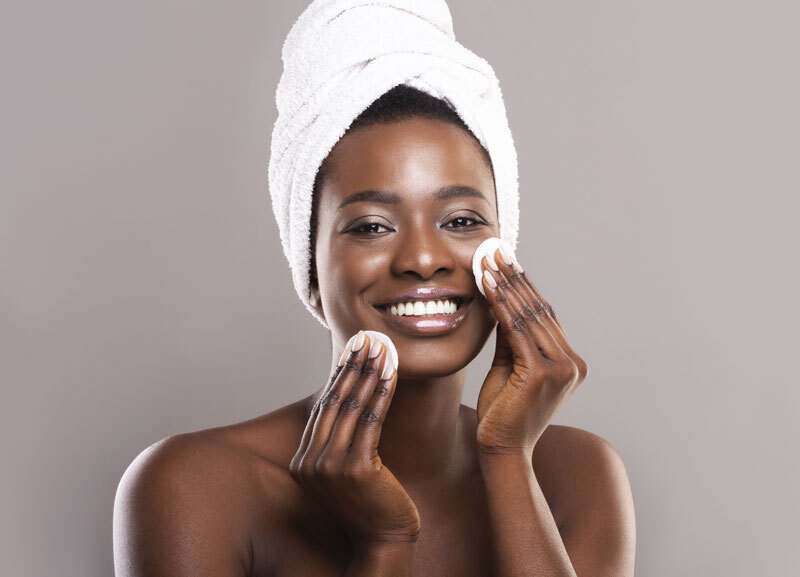Decoding skincare ingredients can feel like a full-time job. When all you want to do is be kind to your skin, body, and the environment, product labels just seem to make it harder. What is quaternium-15, and why can’t I pronounce hydroxymethyl-whatever?
It can be tough to identify harmful ingredients, especially with “clean beauty” brands taking part in the all-too-common greenwashing epidemic. That’s why in this article, we’re discussing five common skincare ingredients to avoid. While this list is by no means exhaustive, it is a great place to start to become a more conscious consumer.
5 Skincare Ingredients to Avoid
Formaldehyde and Formaldehyde Releasers
Not-so-fun-fact: formaldehyde is the chemical you probably used in high school biology to preserve your dead frog before dissecting it. It’s also the chemical used to preserve dead bodies during the Civil War.
TRUTH BOMB:
You’re
Already killing it!
If You Were More Consistent With Your Wellness Routine, You’d Be Unstoppable.
This toxic chemical is a potent carcinogen and something we should avoid using on our skin at all costs. Cosmetic manufacturers don’t typically use the chemical directly, but the reaction of some chemicals release formaldehyde. These are the formaldehyde-releasing ingredients you want to steer clear of:
- DMDM hydantoin
- Imidazolidinyl urea
- Diazolidinyl urea
- Quaternium-15
- Bronopol (2-bromo-2-nitropropane-1,3-diol )
- 5-Bromo-5-nitro-1,3-dioxane
- Hydroxymethylglycinate
- Sodium hydroxymethylglycinate
(1,2)
Parabens
Parabens are a commonly used preservative in cosmetics—and they’re on the list of no-go skincare ingredients. Parabens have been found in breast cancer tumors and are linked to hormone disruption (3).
When our hormones get all out of whack, it can lead to infertility, sexual development problems in infants, irregular periods, PMS issues, brain fog, and more.
When decoding your products, look for any ingredients with the word “paraben” in them or words that start with “ethyl,” “butyl,” “methyl,” or “propyl.”
PEGs
Up next is polyethylene glycols or PEGs. These are petroleum-derived products typically used as thickening and emulsifying agents. One of the problems with PEGs is that they can be super irritating to the skin, causing allergies and sensitivities. For example, petroleum-derived propylene glycol (a common PEG) was selected as the “Allergen of the Year” in 2019 by the American Contact Dermatitis Society.
While there are plant-derived versions of propylene glycol, it is best to avoid the ingredient altogether, especially if you have sensitive skin.
Fragrance
The FDA considers fragrance a “traded-secret”—a proprietary blend formulated from any 3,000 approved dangerous chemicals. Many of these chemicals are phthalates, which contribute to hormone disruption, insulin resistance, decreased levels of sex hormones, and other consequences for the human reproductive system, both for females and males (4).
If fragrance is listed as an ingredient on your skincare, assume that it’s a synthetic fragrance and not a natural one. Essential oils are great alternatives to fragrance—and many clean beauty companies are using oils for beautiful all-natural scents.To learn more about fragrance alternatives, check out this article.
Cyclic Silicones
While cyclic silicones are not inherently bad, there are some clean beauty brands that stay away from them altogether because there is no point to them. In skincare, cyclic silicones make lotions feel silky and smooth, but they don’t actually provide moisture or nutrients, and they tend to be super sticky. That means that they are extremely hard to get off of your skin and that they can clog pores, making them a problem ingredient for acne-prone skin.
While this list only scratches the surface of the problems haunting our cosmetics industry, it’s a solid place to start. Whenever possible, opt for clean beauty products and always double-check them with this list.
For more info on organic skincare and dangerous beauty chemicals, check out these articles:
The Best Organic Makeup Brands that Don’t Compromise on Quality
Chemicals in Makeup & Skin Care
Sources
- “Carcinogens in Cosmetics.” Safe Cosmetics. Retrieved from: http://www.safecosmetics.org/get-the-facts/chemicals-of-concern/known-carcinogens/
- Congleton, J. Exposing the Cosmetics Cover-Up: Is Cancer-Causing Formaldehyde in Your Cosmetics? EWG. Retrieved from: https://www.ewg.org/research/exposing-cosmetics-cover/formaldehyde-releasers
- https://www.ewg.org/sites/humantoxome/chemicals/chemical_classes.php?class=Parabens
- Rustagi, N., Pradhan, S.K., & Singh, R. (2011) Public health impact of plastics: An overview. Indian Journal of Occupational & Environmental Medicine, 15(3), 100-103. Full text: https://www.ncbi.nlm.nih.gov/pmc/articles/PMC3299092/





READ the Latest
Health Habits
Longevity
Health Habits
Health Habits
One Comment